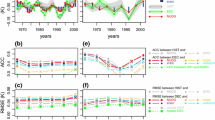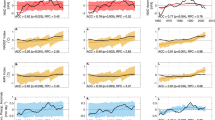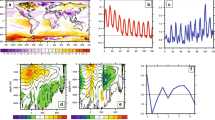Abstract
Decadal climate predictions may have skill due to predictable components in boundary conditions (mainly greenhouse gas concentrations but also tropospheric and stratospheric aerosol distributions) and initial conditions (mainly the ocean state). We investigate the skill of temperature and precipitation hindcasts from a multi-model ensemble of four climate forecast systems based on coupled ocean-atmosphere models. Regional variations in skill with and without trend are compared with similarly analysed uninitialised experiments to separate the trend due to monotonically increasing forcings from fluctuations around the trend due to the ocean initial state and aerosol forcings. In temperature most of the skill in both multi-model ensembles comes from the externally forced trends. The rise of the global mean temperature is represented well in the initialised hindcasts, but variations around the trend show little skill beyond the first year due to the absence of volcanic aerosols in the hindcasts and the unpredictability of ENSO. The models have non-trivial skill in hindcasts of North Atlantic sea surface temperature beyond the trend. This skill is highest in the northern North Atlantic in initialised experiments and in the subtropical North Atlantic in uninitialised simulations. A similar result is found in the Pacific Ocean, although the signal is less clear. The uninitialised simulations have good skill beyond the trend in the western North Pacific. The initialised experiments show some skill in the decadal ENSO region in the eastern Pacific, in agreement with previous studies. However, the results in this study are not statistically significant (p ≈ 0.1) by themselves. The initialised models also show some skill in forecasting 4-year mean Sahel rainfall at lead times of 1 and 5 years, in agreement with the observed teleconnection from the Atlantic Ocean. Again, the skill is not statistically significant (p ≈ 0.2). Furthermore, uninitialised simulations that include volcanic aerosols have similar skill. It is therefore still an open question whether initialisation improves predictions of Sahel rainfall. We conclude that the main source of skill in forecasting temperature is the trend forced by rising greenhouse gas concentrations. The ocean initial state contributes to skill in some regions, but variations in boundary forcings such as aerosols are as important in decadal forecasting.













Similar content being viewed by others
Notes
Priv. Comm., C. C. Raible
References
Bechtold P, Kohler M, Jung T, Doblas-Reyes F, Leutbecher M, Rodwell M, Vitart F, Balsamo G (2008) Advances in simulating atmospheric variability with the ECMWF model: from synoptic to decadal time-scales. Quart J R Meteor Soc 134:1337–1352. doi:10.1002/qj.289
Bhend J, von Storch H (2008) Consistency of observed winter precipitation trends in northern Europe with regional climate change projections. Clim Dyn 31:17–28. doi:10.1007/s00382-007-0335-9
Boer GJ (2004) Long time-scale potential predictability in an ensemble of coupled climate models. Clim Dyn 23(1):29–44. doi:10.1007/s00382-004-0419-8
Brohan P, Kennedy J, Haris I, Tett SFB, Jones PD (2006) Uncertainty estimates in regional and global observed temperature changes: a new dataset from 1850. J Geophys Res 111:D12,106. doi:10.1029/2005JD006548
Coelho CAS, Stephenson DB, Balmaseda M, Doblas-Reyes FJ, van Oldenborgh GJ (2006) Toward an integrated seasonal forecasting system for South America. J Clim 19:3704–3721. doi:10.1175/JCLI3801.1
Collins M (2002) Climate predictability on interannual to decadal time scales: the initial value problem. Clim Dyn 19:671–692. doi:10.1007/s00382-002-0254-8
Cox P, Stephenson D (2007) A changing climate for prediction. Science 317:207–208. doi:10.1126/science.1145956
Delworth TL, Mann ME (2000) Observed and simulated multidecadal variability in the northern hemisphere. Clim Dyn 16:661–676. doi:10.1007/s003820000075
Dijkstra HA, Te Raa LA, Schmeits M, Gerrits J (2006) On the physics of the Atlantic multidecadal oscillation. Ocean Dyn 56:36–50. doi:10.1007/s10236-005-0043-0
Doblas-Reyes FJ, Hagedorn R, Palmer TN (2005) The rationale behind the success of multi-model ensembles in seasonal forecasting—II calibration and combination. Tellus A 57(3):234–252. doi:10.1111/j.1600-0870.2005.00104.x
Doblas-Reyes FJ, Weisheimer A, Palmer TN, Murphy JM, Smith D (2010) Forecast quality assessment of the ENSEMBLES seasonal-to-decadal stream 2 hindcasts. Tech Memo 619, ECMWF. http://www.ecmwf.int/publications/
Dunstone NJ, Smith DM (2010) Impact of atmosphere and sub-surface ocean data on decadal climate prediction. Geophys Res Lett 37:L02,709. doi:10.1029/2009GL041609
Fan Y, van den Dool H (2008) A global monthly land surface air temperature analysis for 1948-present. J Geophys Res 113:D01,103. doi:10.1029/2007JD008470
Guilyardi E (2006) El Niño—mean state—seasonal cycle interactions in a multi-model ensemble. Clim Dyn 26:329–348. doi:10.1007/s00382-005-0084-6
Hagedorn R, Doblas-Reyes FJ, Palmer TN (2005) The rationale behind the success of multi-model ensembles in seasonal forecasting—I. Basic concept. Tellus A 57(3):219–233. doi:10.1111/j.1600-0870.2005.00103.x
Hansen J, Ruedy R, Sato M, Lo K (2010) Global surface temperature change. Rev Geophys 48:RG4004. doi:10.1029/2010RG000345
Hawkins E, Sutton RT (2009) The potential to narrow uncertainty in regional climate predictions. Bull Am Meteorol Soc 90:1095–1107. doi:10.1175/2009BAMS2607.1
Hofer D, Raible CC, Stocker TF (2011) Variations of the Atlantic meridional overturning circulation in control and transient simulations of the last millennium. Clim Past 7(1):133–150. doi:10.5194/cp-7-133-2011
IPCC (2007) Climate Change 2007: the physical science basis. Contribution of working group I to the fourth assessment report of the intergovernmental panel on climate change (IPCC) [Solomon S, Qin D, Manning M, Chen Z, Marquis M, Averyt KB, Tignor M and Miller HL (eds)]. Cambridge University Press, Cambridge
Johns TC, Durman CF, Banks HT, Roberts MJ, McLaren AJ, Ridley JK, Senior CA, Williams KD, Jones A, Rickard GJ, Cusack S, Ingram WJ, Crucifix M, Sexton DMH, Joshi MM, Dong BW, Spencer H, Hill RSR, Gregory JM, Keen AB, Pardaens AK, Lowe JA, Bodas-Salcedo A, Stark S, Searl Y (2006) The new Hadley Centre climate model (HadGEM1): evaluation of coupled simulations. J Clim 19:1327–1353. doi:10.1175/JCLI3712.1
Jungclaus JH, Keenlyside N, Botzet M, Haak H, Luo JJ, Latif M, Marotzke J, Mikolajewicz U, Roeckner E (2006) Ocean circulation and tropical variability in the coupled model ECHAM5/MPI-OM. J Clim 19:3952–3972. doi:10.1175/JCLI3827.1
Keeling CD, Bacastow RB, Bainbridge AE, Ekdahl CA, Guenther P, Waterman LS (1976) Atmospheric carbon dioxide variations at Mauna Loa observatory, Hawaii. Tellus 28:538–551. doi:10.1111/j.2153-3490.1976.tb00701.x
Keenlyside NS, Ba J (2010) Prospects for decadal climate prediction. Wiley Interdiscip Rev Clim Change 1(5):627–635. doi:10.1002/wcc.69
Keenlyside NS, Latif M, Jungclaus J, Kornblueh L, Roeckner E (2008) Advancing decadal-scale climate prediction in the North Atlantic sector. Nature 453:84–88. doi:10.1038/nature06921
Knight JR, Allan RJ, Folland cK, Vellinga M, Mann ME (2005) A signature of persistent natural thermohaline circulation cycles in observed climate. Geophys Res Lett 32:L20,708. doi:10.1029/2005GL024233
Knight JR, Folland CK, Scaife AA (2006) Climate impacts of the Atlantic multidecadal oscillation. Geophys Res Lett 33:L17,706. doi:10.1029/2006GL026242
Knutson TR, Delworth TL, Dixon KW, Held IM, Lu J, Ramaswamy V, Schwarzkopf MD, Stenchikov G, Stouffer RJ (2006) Assessment of twentieth-century regional surface temperature trends using the gfdl cm2 coupled models coupled models. J Clim 19(9):1624–1651. doi:10.1175/JCLI3709.1
van der Linden P, Mitchell JFB (eds) (2009) ENSEMBLES: climate change and its impacts: summary of research and results from the ENSEMBLES project. Met Office Hadley Centre, Fitzroy Road, Exeter EX1 3PB, UK
Livezey RE, Chen WY (1983) Statistical field significance and its determination by Monte Carlo techniques. Mon Wea Rev 111:46–59. doi:10.1175/1520-0493(1983)1110046:SFSAID2.0.CO;2
McCabe GJ, Palecki MA, Betancourt JL (2004) Pacific and Atlantic Ocean influences on multidecadal drought frequency in the united states. Proc Nat Acad Sci 101:4136–4141. doi:10.1073/pnas.0306738101
Meehl G, Teng H, Branstator G (2006) Future changes of El Niño in two coupled climate models. Clim Dyn 26:549–566. doi:10.1007/s00382-005-0098-0
Meehl GA, Arblaster JM (2009) A lagged warm event–like response to peaks in solar forcing in the Pacific region. J Clim 22(13):3647–3660. doi:10.1175/2009JCLI2619.1
Meehl GA, Covey C, Delworth TL, Latif M, McAvaney B, Mitchell JFB, Stouffer RJ, Taylor KE (2007) The WCRP CMIP3 multimodel dataset: a new era in climate change research. Bull Am Met Soc 88:1383–1394. doi:10.1175/BAMS-88-9-1383
Meehl GA, Goddard L, Murphy JM, Stouffer RJ, Boer G, Danabasoglu G, Dixon KW, Giorgetta MA, Greene AM, Hawkins E (2009) Decadal prediction. Can it be skillfull?. Bull Am Met Soc 90(2009):1467–1485. doi:10.1175/2009BAMS2778.1
Mitchell TD, Jones PD (2005) An improved method of constructing a database of monthly climate observations and associated high resolution grids. Int J Climatol 25:693–712. doi:10.1002/joc.1181
Mochizuki T, Ishii M, Kimoto M, Chikamoto Y, Watanabe M, Nozawa T, Sakamoto TT, Shiogama H, Awaji T, Sugiura N, Toyoda T, Yasunaka S, Tatebe H, Mori M (2010) Pacific decadal oscillation hindcasts relevant to near-term climate prediction. PNAS 107(5):1833–1837. doi:10.1073/pnas.0906531107
van Oldenborgh GJ, Balmaseda MA, Ferranti L, Stockdale TN, Anderson DLT (2005a) Did the ECMWF seasonal forecast model outperform statistical ENSO forecasts models over the last 15 years. J Clim 18:3240–3249. doi:10.1175/JCLI3420.1
van Oldenborgh GJ, Philip SY, Collins M (2005b) El Niño in a changing climate: a multi-model study. Ocean Sci 1:81–95. doi:10.5194/os-1-81-2005
van Oldenborgh GJ, Coelho CAS, Doblas-Reyes FJ (2008) Exploratory analysis and verification of seasonal forecasts with the KNMI climate explorer. ECMWF Newslett 116:4–5. http://www.ecmwf.int/publications/newsletters/pdf/116.pdf
van Oldenborgh GJ, Drijfhout SS, van Ulden AP, Haarsma R, SterlC A Severijns, Hazeleger W, Dijkstra HA (2009) Western Europe is warming much faster than expected. Clim Past 5:1–12. doi:10.5194/cp-5-1-2009
van Oldenborgh GJ, te Raa LA, Dijkstra HA, Philip SY (2009) Frequency- or amplitude-dependent effects of the atlantic meridional overturning on the tropical pacific ocean. Ocean Sci 5(3):293–301. doi:10.5194/os-5-293-2009
Pohlmann H, Botzet M, Latif M, Roesch A, Wild M, Tschuck P (2004) Estimating the decadal predictability of a coupled AOGCM. J Clim 17(22):4463–4472. doi:10.1175/3209.1
Pohlmann H, Jungclaus JH, Köhl A, Stammer D, Marotzke J (2009) Initializing decadal climate predictions with the GECCO oceanic synthesis: effects on the North Atlantic. J Clim 22:3926–3938. doi:10.1175/2009JCLI2535.1
Power S, Casey T, Folland C, Colman A, Mehta V (1999) Inter-decadal modulation of the impact of ENSO on Australia. Clim Dyn 15:319–324. doi:10.1007/s003820050284
Press WH, Teukolsky SA, Vetterling WT, Flannery BP (1992) Numerical recipes in FORTRAN: the art of scientific computing. Cambridge University Press, New York
Räsänen J, Ruokolainen L (2006) Probabilistic forecasts of near-term climate change based on a resampling ensemble technique. Tellus A 58:461–472. doi:10.1111/j.1600-0870.2006.00189.x
Robock A (2000) Volcanic eruptions and climate. Rev Geophys 38:191–219. doi:10.1029/1998RG000054
Robson JI (2010) Understanding the performance of a decadal prediction system. PhD thesis, University of Reading
Rotstayn LD, Lohmann U (2002) Tropical rainfall trends and the indirect aerosol effect. J Clim 15(15):2103–2116. doi:10.1175/1520-0442(2002)015<2103:TRTATI>2.0.CO;2
Ruckstuhl C, Norris JR (2009) How do aerosol histories affect solar “dimming” and “brightening” over Europe?: IPCC-AR4 models versus observations. J Geophys Res 114:D00D04. doi:10.1029/2008JD011066
Rudolf B, Becker A, Schneider U, Meyer-Christoffer A, Ziese M (2010) The new “GPCC Full Data Reanalysis Version 5” providing high-quality gridded monthly precipitation data for the global land-surface is public available since December 2010. Tech. rep., GPCC. http://gpcc.dwd.de
Ruokolainen L, Räsänen J (2007) Probabilistic forecasts of near-term climate change: sensitivity to adjustment of simulated variability and choice of baseline period. Tellus A 59(3):309–320. doi:10.1111/j.1600-0870.2007.00233.x
Salas Mélia D (2002) A global coupled sea ice-ocean model. Ocean Model 4(2):137–172. doi:10.1016/S1463-5003(01)00015-4
Schlesinger ME, Ramankutty N (1994) An oscillation in the global climate system of period 65–70 years. Nature 367:723–726. doi:10.1038/367723a0
Shongwe ME, Landman WA, Mason SJ (2006) Performance of recalibration systems for GCM forecasts for southern Africa. Int J Climatol 26:1567–1585. doi:10.1002/joc.1319
Smith DM, Cusack S, Colman AW, Folland CK, Harris GR, Murphy JM (2007) Improved surface temperature prediction for the coming decade from a global climate model. Science 317:796–799. doi:10.1126/science.1139540
Smith DM, Eade R, Dunstone NJ, Fereday D, Murphy JM, Pohlmann H, Scaife AA (2010) Skilful multi-year predictions of Atlantic hurricane frequency. Nat Geosci 3(12):846–849. doi:10.1038/ngeo1004
Smith T, Reynolds R, Peterson T, Lawrimore J (2008) Improvements to NOAA’s historical merged land–ocean surface temperature analysis (1880–2006). J Clim 21:2283–2296. doi:10.1175/2007JCLI2100.1
Solomon A, Goddard L, Kumar A, Carton JA, Deser C, Fukumori I, Greene AM, Hegerl GC, Kirtman B, Kushnir Y, Newman M, Smith D, Vimont D, Delworth TL, Meehl GA, Stockale TN (2011) Distinguishing the roles of natural and anthropogenically forced decadal climate variability: implications for prediction. Bull Am Met Soc 92:141–156. doi:10.1175/2010BAMS2962.1
Stainforth DA, Aina T, Christensen C, Collins M, Faull N, Frame DJ, Kettleborough JA, Knight S, Martin A, Murphy JM, Piani C, Sexton D, Smith LA, Spicer RA, Thorpe AJ, Allen MR (2005) Uncertainty in predictions of the climate response to rising levels of greenhouse gases. Nature 433(7024):403–406. doi:10.1038/nature03301
Stenchikov G, Delworth TL, Ramaswamy V, Stouffer RJ, Wittenberg A, Zeng F (2009) Volcanic signals in oceans. J Geophys Res 114:D16,104. doi:10.1029/2008JD011673
Sterl A, van Oldenborgh GJ, Hazeleger W, Burgers G (2007) On the robustness of ENSO teleconnections. Clim Dyn 29:469–485. doi:10.1007/s00382-007-0251-z
Stott PA (2003) Attribution of regional-scale temperature changes to anthropogenic and natural causes. Geophys Res Lett 30:1728. doi:1029/2003GL017324
Stott PA, Kettleborough JA (2002) Origins and estimates of uncertainty in predictions of twenty-first century temperature rise. Nature 416:723–726. doi:10.1038/416723a
Thompson DWJ, Kennedy JJ, Wallace JM, Jones PD (2008) A large discontinuity in the mid-twentieth century in observed global-mean surface temperature. Nature 453(7195):646–649. doi:10.1038/nature06982
Ting M, Kushnir Y, Seager R, Li C (2009) Forced and internal twentieth-century SST trends in the North Atlantic. J Clim 22(6):1469–1481. doi:10.1175/2008JCLI2561.1
Trenberth KE, Shea DJ (2006) Atlantic hurricanes and natural variability in 2005. Geophys Res Lett 33:L12,704. doi:10.1029/2006GL026894
Weigel AP, Liniger MA, Appenzeller C (2008) Can muti-model combination really enhance the prediction skill of probabilistic ensemble forecasts. Quart J R Meteor Soc 134:241–260. doi:10.1002/qj.210
Weisheimer A, Doblas-Reyes F, Palmer T, Alessandri A, Arribas A, Déqué M, Keenlyside N, MacVean M, Navarra A, Rogel P (2009) ENSEMBLES: a new multi-model ensemble for seasonal-to-annual predictions—skill and progress beyond DEMETER in forecasting tropical Pacific SSTs. Geophys Res Lett 36:L21,711. doi:10.1029/2009GL040896
Wild M (2009) Global dimming and brightening: a review. J Geophys Res 114:D00D16. doi:10.1029/2008JD011470
Yasunaka S, Ishii M, Kimoto M, Mochizuki T, Shiogama H (2011) Influence of XBT temperature bias on decadal climate prediction with a coupled climate model. J Clim 24:5303–5308. http://dx.doi.org/10.1175/2011JCLI4230.1
Zhang R, Delworth TL (2006) Impact of Atlantic multidecadal oscillations on India/Sahel rainfall and Atlantic hurricanes. Geophys Res Lett 33(17):L17,712. doi:10.1029/2006GL026267
Zhang X, Zwiers FW, Hegerl GC, Lambert FH, Gillett NP, Solomon S, Stott PA, Nozawa T (2007) Detection of human influence on twentieth-century precipitation trends. Nature 448:461–465. doi:10.1038/nature06025
Acknowledgments
This work was supported by the EU FP7 large-scale collaborative project THOR (GA212643, 2008-2012) and the QWeCI project (ENV-FP7-2009-1-243964). We acknowledge the FP6 ENSEMBLES project (contract GOCE-CT-2003-505539) for the decadal forecasts and PCMDI for archiving and distributing the CMIP3 data. All data used are available from the ECMWF ENSEMBLES data server and/or the KNMI Climate Explorer.
Author information
Authors and Affiliations
Corresponding author
Rights and permissions
About this article
Cite this article
van Oldenborgh, G.J., Doblas-Reyes, F.J., Wouters, B. et al. Decadal prediction skill in a multi-model ensemble. Clim Dyn 38, 1263–1280 (2012). https://doi.org/10.1007/s00382-012-1313-4
Received:
Accepted:
Published:
Issue Date:
DOI: https://doi.org/10.1007/s00382-012-1313-4




